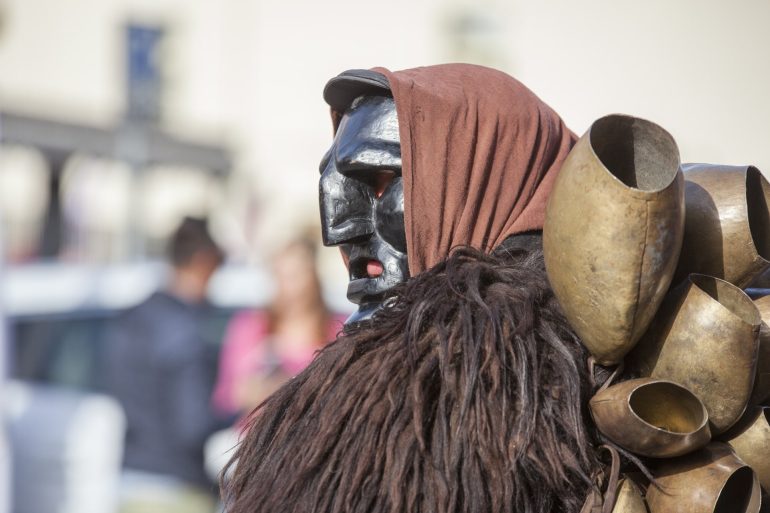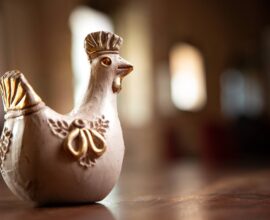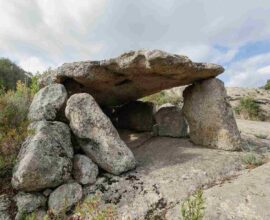Mamoiada, the land of the Mamuthones
Mamoiada, an historical and cultural territory in the heart of Barbagia
Mamoiada is the land of the Mamuthones. It is a charming village, part of the 9th Nuorese mountain community. It is about 15 km from Nuoro, at 644 meters above sea level, in the innermost part of the Barbagia di Ollolai.
This is a historical region of central Sardinia, on the border between the Gennargentu massif and the Supramonte mountain range.
In the area of Mamoiada there are many natural springs and streams perfect for the land used for cultivation or grazing. For this, people used to live there in pre-Nuragic, Nuragic and Roman times. Many anthropological traces and archaeological finds testify to this: the votive stone, the nuraghe, the menhir, the dolmen, the domus de janas and the churches.
The Sa Perda Pintà (painted stone), or Stele of Boeli, is undoubtedly one of the most interesting monuments of Mamoiada. According to scholars it dates back to the culture of Ozieri, that is to the final Neolithic (around 3500 BC). This megalithic stele, found by chance in 1997 during some works in a private garden, is an irregular granite slab, almost three meters high, more than two meters wide and about a half a meter thick.
The Stele of Boeli recalls the typical slabs of the Celtic area (Scotland, Ireland, Corsica, Wales and Brittany). It has a flat concave section, the surface on the back is well-worked while the front shows a series of concentric circles (from a minimum of two to a maximum of seven). The circles are engraved around a central cupel and crossed by a linear incision ending with an arched appendage. 23 cupels of various sizes complete the decoration. Most have a diameter of 20 centimeters and are in the upper and lower left corner of the monument.
The engravings on Sa Perda Pintà seem to refer to the cults of fertility and the cycle of death and rebirth of the seasons. However, according to some studies, the symbols can also be traced back to the cult of the Mother Goddess.
Other noteworthy places are the Church of Loreto, probably built around 1600, with its beautiful frescoed dome, and the sanctuary of Saints Cosma and Damiano. The sanctuary is on the suggestive Marghine plateau and is surrounded by 50 little houses for pilgrims (umbissìas).
The Carnival of Mamoiada. The masks symbol of the Sardinian tradition
The evocative Mamoiada carnival, together with the feast of Sant’Efisio, is one of the oldest popular events in Sardinia. Every year it attracts tourists from all over the island and the world.
The main elements of the Mamoiada carnival are the famous and mysterious masks of the Mamuthones and the Issohadores. These masks are not only an important folkloristic detail, but a real symbol of the territory. The two figures stand out both for their clothes and for the way they move. Their walk seems more like a solemn procession than a carnival parade.
The Mamuthones are men wearing black wooden anthropomorphic masks (visera). Leather straps secure the mask to the face, while a handkerchief covers the head. The men also wear dark furs (mastruca) and have cowbells (carriga) hanging from their backs.
Every year, these masks appear on January 17th, the feast of Sant’Antonio Abate.
The origin of the Mamuthones is still controversial. Oral testimonies attest that the Mamuthones already existed in the 19th century. According to Marcello Madau, archaeologist of the Academy of Fine Arts of Sassari, there is no written evidence that testifies to the presence of the masks in distant times. However, some scholars think that the rite of wearing the masks dates back to the Nuragic age. Others support the idea of a link to the Dionysian rites.
On the other hand, the Issohadores are men who wear white masks, baggy white pants and white canvas shirts with gold buttons. They also wear black wool stockings (cartzas), leather boots (su husinzu) and red bodices (curittu). The elders of Mamoiada call their clothing ‘veste ‘e turcu’, that is Turkish clothes.
But the Issohadore wears also a headdress, called berritta, and various accessories. These include a leather and cloth strap with small rattles (sonajolos), a beautiful embroidered shawl tied at the waist that runs down the left leg, and a rope (soha). With the soha, the Issohadores pretend to capture young women as a sign of good omen for health and fertility. They also capture friends or the local authorities, to wish them a good job. In the past, the Issohadores usually captured the landowners, as a wish for a good year, and they offered wine and sweets in exchange.
The Mamoiada carnival parade begins with the Mamuthones moving slowly and shaking their cowbells with a shoulder swipe. The leader Issohadore sets the pace for the dance while the others, who move with more agile and light steps, throw the ropes to capture the young women.
The group traditionally includes 12 Mamuthones and 8 Issohadores. The former walk in two parallel rows, the latter walk in front, behind and to the side of the Mamuthones. The leader Issohadore remains in a central position so that the Mamuthones can see his movements clearly.
People can admire the masks of the Mamuthones and the Issohadores, together with other masks from different European countries, at the Museum of Mediterranean Masks in Mamoiada. The Museum is open from Tuesday to Sunday, from 9 am to 1 pm and 3 pm to 7 pm. From May to October, the Museum is open also on Mondays.
Do you want to discover the traditions of Sardinia and experience a holiday in a real paradise? Discover Forte Village Resort, the place where dreams come true.






